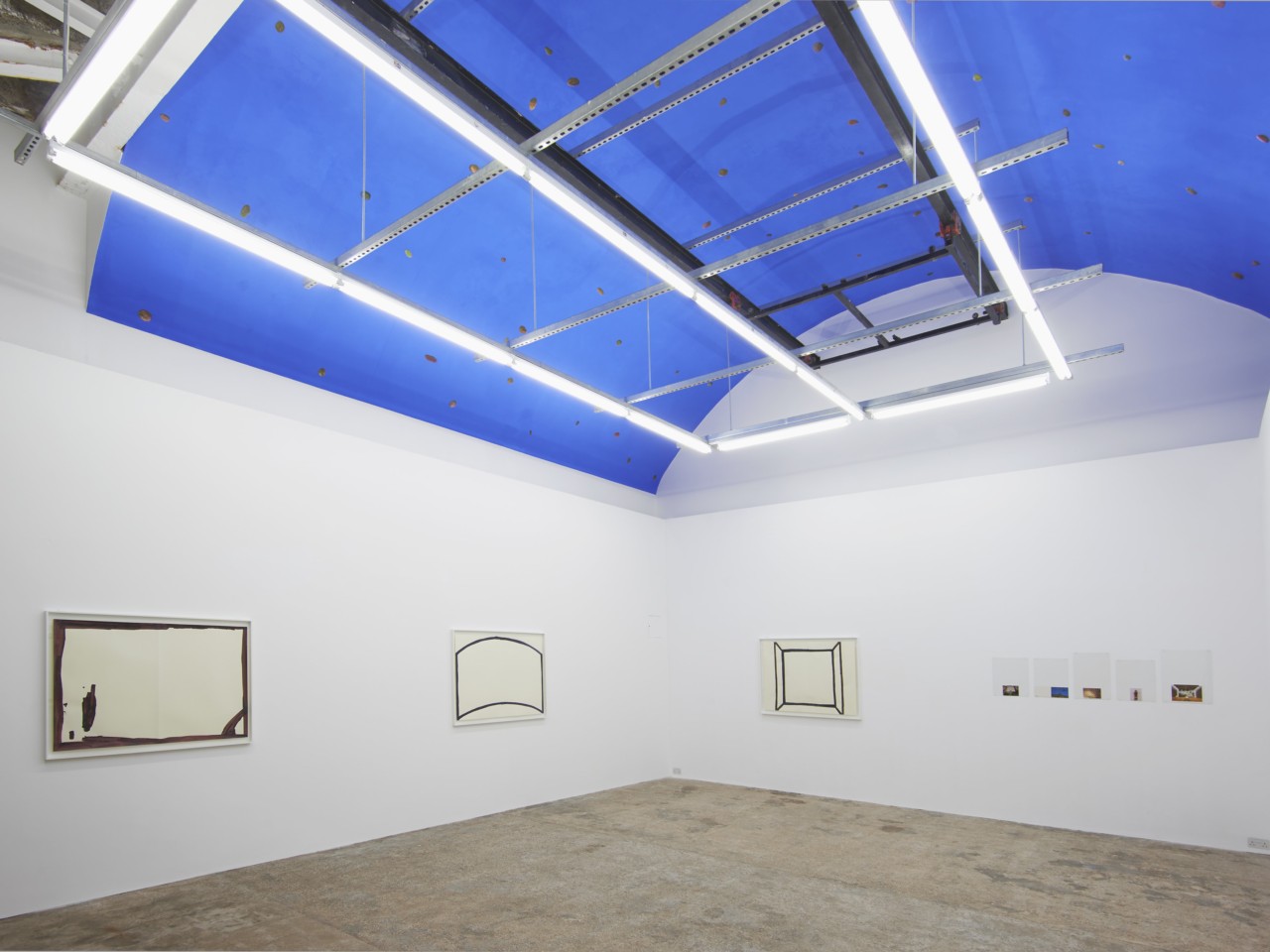


Installation view, Hollybush Gardens. Courtesy the artist. Photo: Andy Keate.
Try to conjure up mental images of potatoes in art. My mind manages hazily remembered 19th century Dutch scenes of exhausted peasants, either picking or dourly eating them. Apples and pears have a much more glamorous art life. Pomegranates and pineapples are freighted with symbolism of fertility, and colonial conquest. Homely potatoes, however have the kind of humility of demeanour that makes them completely coherent with Andrea Büttner’s concerns.
In her fourth exhibition at Hollybush Gardens, Büttner has painted the barrel-vaulted ceiling of the main ground floor space in dazzling cobalt blue and dotted it with life-size painted potatoes. The immediate effect is sublimely uplifting – the colour itself seemed to have a physical effect on my mood.
The reference for this piece is Giotto’s early 14th century masterpiece, the Scrovegni Chapel in Padua. There, the famous ceiling shows the azure heavens with the constellations replaced by a gold-leafed Madonna and child, depicted in the centre like the sun, and the prophets as planets. In Painted Ceiling (potatoes), 2019, these figures are replaced with the humble potato, suspended in space with the same lack of concern for the laws of gravity as the holy family. Padua comes to Clerkenwell.
In earlier exhibitions Büttner has painted the walls of galleries chocolate – or shit – brown, up to the limit of her own arm’s reach. But that earth-bound gesture in the architecture is quite different from this soaring intervention, where the reference is so directly to a particular ecclesiastical architecture.
The artist wrote her Royal College of Art PhD thesis on the relationship between art and shame and that subject, particularly in connection with Catholicism, has been a constant in her work. She has focussed repeatedly on the humility and quietude that characterise the lives of Carmelite nuns. Earlier bodies of work have featured details of the architecture of convents: carvings and ornate grilles.
Poverty, modesty, smallness are qualities that have manifested in different ways. During a period of research from 2012-14 at the National Museum of Wales, Büttner drew on the world-renowned botanical collections in Cardiff to incorporate live mosses, some of the most ancient, simple and almost invisible plant life, into her exhibition.
Early on in her career, Büttner chose the archaic medium of woodcut prints, precisely because the medium was so peripheral to contemporary concerns. In our ever more clamorous world, this patient emphasis on the humble is salutary, welcome.
In the current exhibition, four works on paper, all Untitled, 2019, are in fact ink drawings, rather than woodcuts. They feature elegantly pared-back, frame-like forms rendered in crisp, sweeping gestures, with a curve to the upper edge that connects pleasingly to the arcing ceiling above. Aside from their consummate poise, they trigger sequences of thoughts about the way architectures frame artworks, how the two work together to produce symbolic power.
The Scrovegni Chapel could not be considered a modest entity, and neither could the other religious buildings referenced in work in the ground-floor space at Hollybush Gardens. Here are postcards depicting highly charged sites in Germany and the UK, religious buildings constructed in the immediate post-war period in a spirit of atonement and of memorial: John Piper’s stained glass windows in Coventry Cathedral; the altar fresco mural in the Maria Regina Martyrum Roman Catholic church, sited next to the former Plotzensee Prison in Berlin; the Karmel Heilig Blut Dachau, founded in 1964 near the site of the former concentration camp Dachau.
On the upper floor, three sculptures take the form of architectural maquettes. They recreate in cardboard, paint and bookbinding linen, the rarefied spaces of the Deutsche Bundesbank Dining Room, the Rockefeller Dining Room in New York and the Münter Haus, Murnau, that was home to Wassily Kandinsky and Gabrielle Münter before the Second World War. A meeting place for the avant-garde Blaue Reiter group of artists, it was also the place where Münter hid large numbers of their canvasses from the Nazis. She revealed them in 1956 and donated many to the Lenbachhaus in Munich, overnight transforming it into a world class museum.
Nelson Rockerfeller’s dining room also holds an important place in the history of abstract painting in the 20th century. It was the site of a commission from the Swiss-American painter Fritz Glarner; in 1987 the whole installation was sold and is now in the collection of the Museum Haus Konstruktiv in Zurich. In all three maquettes the interiors are rendered in planes of strong colour, rather than recreating the original painted schemes. By separating out the architectural context from the artworks they contained, the works probe the relationship of the commission to the commissioner to the artist – putting in play the socio-economic and political framing of the eventual art works.
This is an exceptionally strong show by an artist whose thinking continues to be brilliantly subtle, complex and surprising. Make sure not to miss it.
Caroline Douglas
Director
Hollybush Gardens, 1–2 Warner Yard, London EC1R 5EY. Open Wednesday-Friday11.00-18.00, Saturday 12.00-17.00. Exhibition continues until 14 December 2019. www.hollybushgardens.co.uk